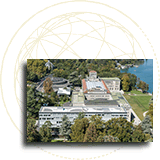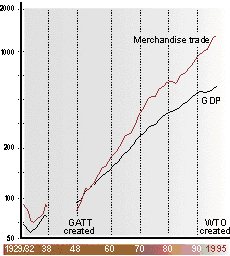UNDERSTANDING THE WTO:
BASICS
The case for open trade
The economic case for an open trading system based on multilaterally agreed rules is simple enough and rests largely on commercial common sense. But it is also supported by evidence: the experience of world trade and economic growth since the Second World War. Tariffs on industrial products have fallen steeply and now average less than 5% in industrial countries. During the first 25 years after the war, world economic growth averaged about 5% per year, a high rate that was partly the result of lower trade barriers. World trade grew even faster, averaging about 8% during the period.
The data show a definite statistical link between freer trade and economic growth. Economic theory points to strong reasons for the link. All countries, including the poorest, have assets — human, industrial, natural, financial — which they can employ to produce goods and services for their domestic markets or to compete overseas. Economics tells us that we can benefit when these goods and services are traded. Simply put, the principle of “comparative advantage” says that countries prosper first by taking advantage of their assets in order to concentrate on what they can produce best, and then by trading these products for products that other countries produce best.
In other words, liberal trade policies — policies that allow the unrestricted flow of goods and services — sharpen competition, motivate innovation and breed success. They multiply the rewards that result from producing the best products, with the best design, at the best price.
But success in trade is not static. The ability to compete well in particular products can shift from company to company when the market changes or new technologies make cheaper and better products possible. Producers are encouraged to adapt gradually and in a relatively painless way. They can focus on new products, find a new “niche” in their current area or expand into new areas.
Experience shows that competitiveness can also shift between whole countries. A country that may have enjoyed an advantage because of lower labour costs or because it had good supplies of some natural resources, could also become uncompetitive in some goods or services as its economy develops. However, with the stimulus of an open economy, the country can move on to become competitive in some other goods or services. This is normally a gradual process.
Nevertheless, the temptation to ward off the challenge of competitive imports is always present. And richer governments are more likely to yield to the siren call of protectionism, for short term political gain — through subsidies, complicated red tape, and hiding behind legitimate policy objectives such as environmental preservation or consumer protection as an excuse to protect producers.
Protection ultimately leads to bloated, inefficient producers supplying consumers with outdated, unattractive products. In the end, factories close and jobs are lost despite the protection and subsidies. If other governments around the world pursue the same policies, markets contract and world economic activity is reduced. One of the objectives that governments bring to WTO negotiations is to prevent such a self-defeating and destructive drift into protectionism.
> more on research and analysis
Share
TRUE AND NON-TRIVIAL?
Nobel laureate Paul Samuelson was once challenged by the mathematician Stanislaw Ulam to “name me one proposition in all of the social sciences which is both true and non-trivial.”
Samuelson’s answer? Comparative advantage.
“That it is logically true need not be argued before a mathematician; that it is not trivial is attested by the thousands of important and intelligent men who have never been able to grasp the doctrine for themselves or to believe it after it was explained to them.”
Comparative advantage
This is arguably the single most powerful insight into economics.
Suppose country A is better than country B at making automobiles, and country B is better than country A at making bread. It is obvious (the academics would say “trivial”) that both would benefit if A specialized in automobiles, B specialized in bread and they traded their products. That is a case of absolute advantage.
But what if a country is bad at making everything? Will trade drive all producers out of business? The answer, according to Ricardo, is no. The reason is the principle of comparative advantage.
It says, countries A and B still stand to benefit from trading with each other even if A is better than B at making everything. If A is much more superior at making automobiles and only slightly superior at making bread, then A should still invest resources in what it does best — producing automobiles — and export the product to B. B should still invest in what it does best — making bread — and export that product to A, even if it is not as efficient as A. Both would still benefit from the trade. A country does not have to be best at anything to gain from trade. That is comparative advantage.
The theory dates back to classical economist David Ricardo. It is one of the most widely accepted among economists. It is also one of the most misunderstood among non-economists because it is confused with absolute advantage.
It is often claimed, for example, that some countries have no comparative advantage in anything. That is virtually impossible.
Think about it ...

